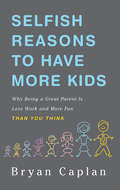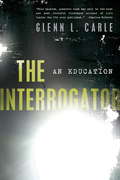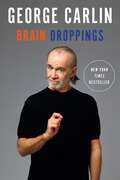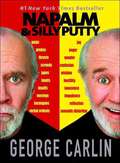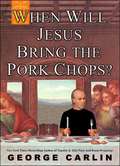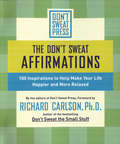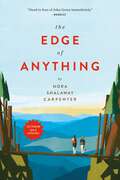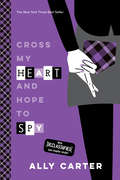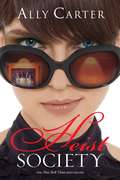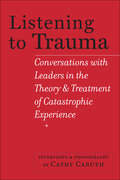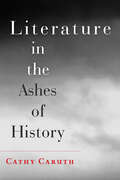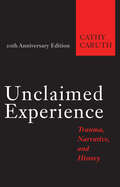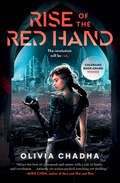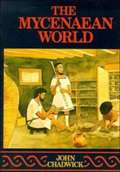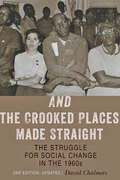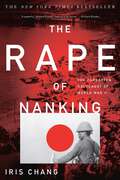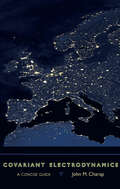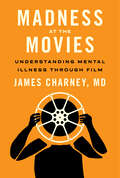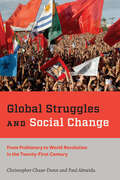- Table View
- List View
Selfish Reasons to Have More Kids: Why Being a Great Parent is Less Work and More Fun Than You Think
by Bryan CaplanWe've needlessly turned parenting into an unpleasant chore. Parents invest more time and money in their kids than ever, but the shocking lesson of twin and adoption research is that upbringing is much less important than genetics in the long run. These revelations have surprising implications for how we parent and how we spend time with our kids. The big lesson: Mold your kids less and enjoy your life more. Your kids will still turn out fine.Selfish Reasons to Have More Kids is a book of practical big ideas. How can parents be happier? What can they change--and what do they need to just accept? Which of their worries can parents safely forget? Above all, what is the right number of kids for you to have? You'll never see kids or parenthood the same way again.
The Interrogator: An Education
by Glenn L. CarleTo his friends and neighbors, Glenn L. Carle was a wholesome, stereotypical New England Yankee, a former athlete struggling against incipient middle age, someone always with his nose in an abstruse book. But for two decades Carle broke laws, stole, and lied on a daily basis about nearly everything. &“I was almost never who I said I was, or did what I claimed to be doing.&” He was a CIA spy. He thrived in an environment of duplicity and ambiguity, flourishing in the gray areas of policy. The Interrogator is the story of Carle&’s most serious assignment, when he was &“surged&” to become an interrogator in the U.S. Global War on Terror to interrogate a top level detainee at one of the CIA&’s notorious black sites overseas. It tells of his encounter with one of the most senior al-Qa&’ida detainees the U.S. captured after 9/11, a &“ghost detainee&” who, the CIA believed, might hold the key to finding Osama bin Ladin.As Carle&’s interrogation sessions progressed though, he began to seriously doubt the operation. Was this man, kidnapped in the Middle East, really the senior al-Qa&’ida official the CIA believed he was? Headquarters viewed Carle&’s misgivings as naïve troublemaking. Carle found himself isolated, progressively at odds with his institution and his orders. He struggled over how far to push the interrogation, wrestling with whether his actions constituted torture, and with what defined his real duty to his country. Then, in a dramatic twist, headquarters spirited the detainee and Carle to the CIA&’s harshest interrogation facility, a place of darkness and fear, which even CIA officers only dared mention in whispers.A haunting tale of sadness, confusion, and determination, The Interrogator is a shocking and intimate look at the world of espionage. It leads the reader through the underworld of the Global War on Terror, asking us to consider the professional and personal challenges faced by an intelligence officer during a time of war, and the unimaginable ways in which war alters our institutions and American society.
Brain Droppings
by George CarlinSometimes, a little brain damage can help. A book of original humor pieces by beloved comic George Carlin. Filled with thoughts, musings, questions, lists, beliefs, curiosities, monologues, assertions, assumptions, and other verbal ordeals, Brain Droppings is infectiously funny. Also included are two timeless monologues, "A Place for Your Stuff" and "Baseball-Football." Readers will get an inside look into Carlin's mind, and they won't be disappointed by what they find: I buy stamps by mail. It works OK until I run out of stamps.What year did Jesus Christ think it was?A tree: first you chop it down, then you chop it up.Have you ever noticed the lawyer is always smiling more than the client?I put a dollar in one of those change machines. Nothing changed.If you ever have chicken at lunch and chicken at dinner, do you ever wonder if the two chickens knew each other? Carlin demolishes everyday values and yet leaves you laughing out loud.
Napalm & Silly Putty
by George CarlinA hilarious new collection of razor-sharp observations from the New York Times bestselling author of Brain Droppings. Few comics make the transition from stage to page as smoothly or successfully as George Carlin. Brain Droppings spent a total of 40 weeks on the New York Times bestseller list, and this new one is certain to tickle even more ribs (and rattle a few more cages) with its characteristically ironic take on life's annoying universal truths. In Napalm & Silly Putty, Carlin doesn't steer clear of the tough issues, preferring instead to look life boldly in the eye to pose the questions few dare to ask:How can it be a spy satellite if they announce on TV that it's a spy satellite?Why do they bother saying "raw sewage"? Do some people cook that stuff?In the expression "topsy-turvy," what exactly is meant by "turvy"? And he makes some startling observations, including:Most people with low self-esteem have earned it.Guys don't seem to be called "Lefty" anymore.Most people don't know what they're doing, and a lot of them are really good at it. Carlin also waxes wickedly philosophical on all sorts of subjects, including:KIDS--They're not all cute. In fact, if you look at them closely, some of them are rather unpleasant looking. And a lot of them don't smell too good either.DEATH ROW--If you're condemned to die they have to give you one last meal of your own request. What is that all about? A group of people plan to kill you, so they want you to eat something you like? Add to the mix "The Ten Most Embarrassing Songs of All Time," "The 20th Century Hostility Scoreboard," and "People I Can Do Without," and you have an irresistibly insouciant assortment of musings, questions, assertions, and assumptions guaranteed to please the millions of fans waiting for the next Carlin collection--and the millions more waiting to discover this comic genius.
When Will Jesus Bring the Pork Chops?: An Orgy Of George Including Brain Droppings, Napalm And Silly Putty, And When Will Jesus Bring The Pork Chops?
by George CarlinOn the heels of George Carlin's #1 New York Times bestseller Napalm & Silly Putty comes When Will Jesus Bring the Pork Chops? -- infused with Carlin's trademark irreverent humor and biting cultural observations. Here we go again . . . George Carlin's hilarious When Will Jesus Bring the Pork Chops? offers his cutting-edge opinions and observational humor on everything from evasive euphemistic language to politicians to the media to dead people. Nothing and no one is safe! Despite the current climate of political correctness, Carlin is not afraid to take on controversial topics:Carlin on the media: The media comprises equal parts business, politics, advertising, public relations, and show business. Nice combination. Enough bull for Texas to open a chain of branch offices.Carlin on the battle of the sexes: Here's all you have to know about men and women: women are crazy, men are stupid. And the main reason women are crazy is that men are stupid.Carlin on hygiene: When did they pass a law that says the people who make my sandwich have to be wearing gloves? I'm not comfortable with this. I don't want glove residue all over my food; it's not sanitary. Who knows where these gloves have been?Carlin on evasive language: Just to demonstrate how far using euphemisms in language has gone, some psychologists are now actually referring to ugly people as those with "severe appearance deficits." Hey, Doctor. How's that for "denial"?Carlin on politics: No self-respecting politician would ever admit to working in the government. They prefer to think of themselves "serving the nation." To help visualize the service they provide the country, you may wish to picture the things that take place on a stud farm. The thinking person's comic who uses words as weapons, Carlin puts voice to issues that capture the modern imagination. For instance, why are there Ten Commandments? Are UFOs real? What will the future really be like? This brand-new collection tackles all that and more. In When Will Jesus Bring the Pork Chops? Carlin's razor-sharp observations demolish everyday values and leave you laughing out loud--delivering exactly what his countless fans have been waiting for.
The Don't Sweat Affirmations: 100 Inspirations to Help Make Your Life Happier and More Relaxed
by Richard Carlson100 affirmations that reinforce the don't sweat philosophy of life: that not letting the little things get to you is a great way to reduce stress overall. These peaceful, beautifully written affirmations are simple statements that hold a big impact. Readers who repeat only several affirmations a day will find their lives becoming more calm and less frantic immediately.
The Edge of Anything
by Nora Shalaway CarpenterStarred Kirkus Review!A vibrant #ownvoices debut YA novel about grief, mental health, and the transformative power of friendship.Len is a loner teen photographer haunted by a past that's stagnated her work and left her terrified she's losing her mind. Sage is a high school volleyball star desperate to find a way around her sudden medical disqualification. Both girls need college scholarships. After a chance encounter, the two develop an unlikely friendship that enables them to begin facing their inner demons.But both Len and Sage are keeping secrets that, left hidden, could cost them everything, maybe even their lives.Set in the North Carolina mountains, this dynamic #ownvoices novel explores grief, mental health, and the transformative power of friendship.
Cross My Heart and Hope to Spy (Gallagher Girls #2)
by Ally CarterAfter the excitement of the fall, all Cammie Morgan wants is peaceful semester at school. But that's easier said than done when you're a CIA legacy and go to the premier school in the world...for spies.Despite Cammie's best intentions, trouble crops up quickly. Cammie, Bex, and Liz learn that the Gallagher Academy is hosting guests from another spy school -- a school that is known to the world as the Ethan Frome Academy--a secret spy school for boys. After her fiasco with Josh last fall, Cammie isn't sure she's ready for daily encounters with boy spies especially after she meets Zach -- an incorrigibe cutie who everyone thinks is just perfect. Cammie is right to be worried about their new guests. Soon after the boys' arrival, she's blamed for a series of security breaches that leave the school's top-secret status at risk. And the perfectly crushable Zach is her prime suspect.
Heist Society: Book 1 (A Heist Society Novel #1)
by Ally CarterWhen Katarina Bishop was three, her parents took her to the Louvre...to case it. For her seventh birthday, Katarina and her Uncle Eddie traveled to Austria...to steal the crown jewels. When Kat turned fifteen, she planned a con of her own--scamming her way into the best boarding school in the country, determined to leave the family business behind. Unfortunately, leaving "the life" for a normal life proves harder than she'd expected. Soon, Kat's friend and former co-conspirator, Hale, appears out of nowhere to bring her back into the world she tried so hard to escape. But he has good reason: a powerful mobster's art collection has been stolen, and he wants it returned. Only a master thief could have pulled this job, and Kat's father isn't just on the suspect list, he is the list. Caught between Interpol and a far more deadly enemy, Kat's dad needs her help.For Kat there is only one solution: track down the paintings and steal them back. So what if it's a spectacularly impossible job? She's got two weeks, a teenage crew, and hopefully just enough talent to pull off the biggest heist in her family's (very crooked) history--and, with any luck, steal her life back along the way.
Listening to Trauma: Conversations with Leaders in the Theory and Treatment of Catastrophic Experience
by Cathy CaruthThis new collection from Cathy Caruth features interviews with a diverse group of leaders in the theorization of, and response to, traumatic experience in the twentieth and twenty-first centuries. Crossing the boundaries of discipline and profession, Caruth’s subjects include literary theorists and critics, psychoanalysts, psychiatrists, psychologists, political activists, filmmakers, public intellectuals, institutional leaders, and researchers. Exploring the intertwining of the intellectual and personal dimensions of experience, each interview is accompanied by Caruth's intimate photographic portrait of its subject. Caruth chose her subjects because of their impact on her thinking as well as their significant role as witnesses to the collective and cultural significance of trauma. The individuals profiled here are innovators in the theory of trauma (Part I), in the clinical, activist, or testimonial interventions in trauma (Part II), or in the creation or modification of institutions that provide therapeutic, artistic, or legal responses to traumatic events (Part III). Two of the interviews first appeared in Caruth's landmark 1995 work, Trauma: Explorations in Memory. The rest were conducted between 2011 and 2013 after the field of trauma studies expanded significantly. Representing both the foundation of trauma research and cutting-edge approaches to the topic, this collection will be useful to practitioners with an interest in post-traumatic stress disorder as well as scholars exploring the multiple dimensions of profound human experience.A portion of the proceeds from sales of this book will go to the Grady Nia Project for abused, suicidal, and low-income African American women.
Listening to Trauma: Conversations with Leaders in the Theory and Treatment of Catastrophic Experience
by Cathy CaruthThis new collection from Cathy Caruth features interviews with a diverse group of leaders in the theorization of, and response to, traumatic experience in the twentieth and twenty-first centuries. Crossing the boundaries of discipline and profession, Caruth’s subjects include literary theorists and critics, psychoanalysts, psychiatrists, psychologists, political activists, filmmakers, public intellectuals, institutional leaders, and researchers. Exploring the intertwining of the intellectual and personal dimensions of experience, each interview is accompanied by Caruth's intimate photographic portrait of its subject. Caruth chose her subjects because of their impact on her thinking as well as their significant role as witnesses to the collective and cultural significance of trauma. The individuals profiled here are innovators in the theory of trauma (Part I), in the clinical, activist, or testimonial interventions in trauma (Part II), or in the creation or modification of institutions that provide therapeutic, artistic, or legal responses to traumatic events (Part III). Two of the interviews first appeared in Caruth's landmark 1995 work, Trauma: Explorations in Memory. The rest were conducted between 2011 and 2013 after the field of trauma studies expanded significantly. Representing both the foundation of trauma research and cutting-edge approaches to the topic, this collection will be useful to practitioners with an interest in post-traumatic stress disorder as well as scholars exploring the multiple dimensions of profound human experience.A portion of the proceeds from sales of this book will go to the Grady Nia Project for abused, suicidal, and low-income African American women.
Literature in the Ashes of History
by Cathy CaruthCathy Caruth juxtaposes the writings of psychoanalysts, literary and political theorists, and literary authors who write in a century faced by a new kind of history, one that is made up of events that seem to undo, rather than produce, their own remembrance. At the heart of each chapter is the enigma of a history that, in its very unfolding, seems to be slipping away before our grasp. What does it mean for history to disappear? And what does it mean to speak of a history that disappears? These questions, Caruth suggests, lie at the center of the psychoanalytic texts that frame this book, as well as the haunting stories and theoretical arguments that resonate with each other in profound and surprising ways. In the writings of Honoré de Balzac, Hannah Arendt, Ariel Dorfman, Wilhelm Jensen, Sigmund Freud, and Jacques Derrida, we encounter, across different stakes and different languages, a variety of narratives that bear witness not simply to the past but also to the pasts we have not known and that repeatedly return us to a future that remains beyond imagination.These stories of trauma cannot be limited to the catastrophes they name, and the theory of catastrophic history may ultimately be written in a language that already lingers in a time that comes to us from the other side of the disaster.
Literature in the Ashes of History
by Cathy CaruthCathy Caruth juxtaposes the writings of psychoanalysts, literary and political theorists, and literary authors who write in a century faced by a new kind of history, one that is made up of events that seem to undo, rather than produce, their own remembrance. At the heart of each chapter is the enigma of a history that, in its very unfolding, seems to be slipping away before our grasp. What does it mean for history to disappear? And what does it mean to speak of a history that disappears? These questions, Caruth suggests, lie at the center of the psychoanalytic texts that frame this book, as well as the haunting stories and theoretical arguments that resonate with each other in profound and surprising ways. In the writings of Honoré de Balzac, Hannah Arendt, Ariel Dorfman, Wilhelm Jensen, Sigmund Freud, and Jacques Derrida, we encounter, across different stakes and different languages, a variety of narratives that bear witness not simply to the past but also to the pasts we have not known and that repeatedly return us to a future that remains beyond imagination.These stories of trauma cannot be limited to the catastrophes they name, and the theory of catastrophic history may ultimately be written in a language that already lingers in a time that comes to us from the other side of the disaster.
Unclaimed Experience: Trauma, Narrative, and History
by Cathy CaruthIn Unclaimed Experience, Cathy Caruth proposes that in the widespread and bewildering experience of trauma in our century;¢;‚¬;€?both in its occurrence and in our attempt to understand it;¢;‚¬;€?we can recognize the possibility of a history no longer based on simple models of straightforward experience and reference. Through the notion of trauma, she contends, we come to a new understanding that permits history to arise where immediate understanding may not. Caruth explores the ways in which the texts of psychoanalysis, literature, and literary theory both speak about and speak through the profound story of traumatic experience. Rather than straightforwardly describing actual case studies of trauma survivors, or attempting to elucidate directly the psychiatry of trauma, she examines the complex ways that knowing and not knowing are entangled in the language of trauma and in the stories associated with it. Caruth;€™s wide-ranging discussion touches on Freud;€™s theory of trauma as outlined in Moses and Monotheism and Beyond the Pleasure Principle. She traces the notion of reference and the figure of the falling body in de Man, Kleist, and Kant; the narratives of personal catastrophe in Hiroshima mon amour; and the traumatic address in Lecompte;€™s reinterpretation of Freud;€™s narrative of the dream of the burning child. In this twentieth-anniversary edition of her now classic text, a substantial new afterword addresses major questions and controversies surrounding trauma theory that have arisen over the past two decades. Caruth offers innovative insights into the inherent connection between individual and collective trauma, on the importance of the political and ethical dimensions of the theory of trauma, and on the crucial place of literature in the theoretical articulation of the very concept of trauma. Her afterword serves as a decisive intervention in the ongoing discussions in and about the field.
Unclaimed Experience: Trauma, Narrative, and History
by Cathy CaruthIn Unclaimed Experience, Cathy Caruth proposes that in the widespread and bewildering experience of trauma in our century;¢;‚¬;€?both in its occurrence and in our attempt to understand it;¢;‚¬;€?we can recognize the possibility of a history no longer based on simple models of straightforward experience and reference. Through the notion of trauma, she contends, we come to a new understanding that permits history to arise where immediate understanding may not. Caruth explores the ways in which the texts of psychoanalysis, literature, and literary theory both speak about and speak through the profound story of traumatic experience. Rather than straightforwardly describing actual case studies of trauma survivors, or attempting to elucidate directly the psychiatry of trauma, she examines the complex ways that knowing and not knowing are entangled in the language of trauma and in the stories associated with it. Caruth;€™s wide-ranging discussion touches on Freud;€™s theory of trauma as outlined in Moses and Monotheism and Beyond the Pleasure Principle. She traces the notion of reference and the figure of the falling body in de Man, Kleist, and Kant; the narratives of personal catastrophe in Hiroshima mon amour; and the traumatic address in Lecompte;€™s reinterpretation of Freud;€™s narrative of the dream of the burning child. In this twentieth-anniversary edition of her now classic text, a substantial new afterword addresses major questions and controversies surrounding trauma theory that have arisen over the past two decades. Caruth offers innovative insights into the inherent connection between individual and collective trauma, on the importance of the political and ethical dimensions of the theory of trauma, and on the crucial place of literature in the theoretical articulation of the very concept of trauma. Her afterword serves as a decisive intervention in the ongoing discussions in and about the field.
Rise of the Red Hand (The\mechanists Ser. #1)
by Olivia ChadhaA rare, searing portrayal of the future of climate change in South Asia. A streetrat turned revolutionary and the disillusioned hacker son of a politician try to take down a ruthlessly technocratic government that sacrifices its poorest citizens to build its utopia.
The Mycenaean World (PDF)
by John ChadwickJohn Chadwick summarizes the results of research into Mycenaean Greece and in so doing opens the door to a new world, Mycenaean Greece seen through the eyes of its inhabitants.
And the Crooked Places Made Straight: The Struggle for Social Change in the 1960s (The American Moment)
by David ChalmersDavid Chalmers's widely acclaimed overview of the 1960s describes how the civil rights movement touched off a growing challenge to traditional values and arrangements. Chalmers recounts the judicial revolution that set national standards for race, politics, policing, and privacy. He examines the long, losing war on poverty and the struggle between the media and the government over the war in Vietnam. He follows feminism's "second wave" and the emergence of the environmental, consumer, and citizen action movements. He also explores the worlds of rock, sex, and drugs, and the entwining of the youth culture, the counterculture, and the American marketplace.This newly revised edition covers the conservative counter-revolution and cultural wars. It carries the legacy of the 1960s forward: from Tom Hayden’s idealistic 1962 Port Huron Statement through Newt Gingrich’s 1994 "Contract with America" and Grover Norquist’s twenty-first century "Tax Payer’s Protection Pledge."
And the Crooked Places Made Straight: The Struggle for Social Change in the 1960s (The American Moment)
by David ChalmersDavid Chalmers's widely acclaimed overview of the 1960s describes how the civil rights movement touched off a growing challenge to traditional values and arrangements. Chalmers recounts the judicial revolution that set national standards for race, politics, policing, and privacy. He examines the long, losing war on poverty and the struggle between the media and the government over the war in Vietnam. He follows feminism's "second wave" and the emergence of the environmental, consumer, and citizen action movements. He also explores the worlds of rock, sex, and drugs, and the entwining of the youth culture, the counterculture, and the American marketplace.This newly revised edition covers the conservative counter-revolution and cultural wars. It carries the legacy of the 1960s forward: from Tom Hayden’s idealistic 1962 Port Huron Statement through Newt Gingrich’s 1994 "Contract with America" and Grover Norquist’s twenty-first century "Tax Payer’s Protection Pledge."
The Rape Of Nanking: The Forgotten Holocaust Of World War II
by Iris ChangThe New York Times bestselling account of one of history's most brutal -- and forgotten -- massacres, when the Japanese army destroyed China's capital city on the eve of World War II In December 1937, one of the most horrific atrocities in the long annals of wartime barbarity occurred. The Japanese army swept into the ancient city of Nanking (what was then the capital of China), and within weeks, more than 300,000 Chinese civilians and soldiers were systematically raped, tortured, and murdered. In this seminal work, Iris Chang, whose own grandparents barely escaped the massacre, tells this history from three perspectives: that of the Japanese soldiers, that of the Chinese, and that of a group of Westerners who refused to abandon the city and created a safety zone, which saved almost 300,000 Chinese. Drawing on extensive interviews with survivors and documents brought to light for the first time, Iris Chang's classic book is the definitive history of this horrifying episode. "Chang vividly, methodically, records what happened, piecing together the abundant eyewitness reports into an undeniable tapestry of horror." - Adam Hochschild, Salon
Covariant Electrodynamics: A Concise Guide
by John M. CharapA notoriously difficult subject, covariant electrodynamics is nonetheless vital for understanding relativistic field theory. John M. Charap’s classroom-tested introduction to the mathematical foundations of the topic presents the material in an approachable manner.Charap begins with a historical overview of electrodynamics and a discussion of the preliminary mathematics one needs in order to grasp the advanced and abstract concepts underlying the theory. He walks the reader through Maxwell’s four equations, explaining how they were developed and demonstrating how they are applied. From there, Charap moves through the other components of electrodynamics, such as Lorentz transformations, tensors, and charged particle behavior. At each point, he carefully works through the mathematics, applies the concepts to simple physical systems, and provides historical context that makes clear the connections among the theories and the mathematicians responsible for developing them. A concluding chapter reviews the history of electrodynamics and points the way for independent testing of the theory.Thorough, evenly paced, and intuitive, this friendly introduction to high-level covariant electrodynamics is a handy and helpful addition to any physicist’s toolkit.
Covariant Electrodynamics: A Concise Guide
by John M. CharapA notoriously difficult subject, covariant electrodynamics is nonetheless vital for understanding relativistic field theory. John M. Charap’s classroom-tested introduction to the mathematical foundations of the topic presents the material in an approachable manner.Charap begins with a historical overview of electrodynamics and a discussion of the preliminary mathematics one needs in order to grasp the advanced and abstract concepts underlying the theory. He walks the reader through Maxwell’s four equations, explaining how they were developed and demonstrating how they are applied. From there, Charap moves through the other components of electrodynamics, such as Lorentz transformations, tensors, and charged particle behavior. At each point, he carefully works through the mathematics, applies the concepts to simple physical systems, and provides historical context that makes clear the connections among the theories and the mathematicians responsible for developing them. A concluding chapter reviews the history of electrodynamics and points the way for independent testing of the theory.Thorough, evenly paced, and intuitive, this friendly introduction to high-level covariant electrodynamics is a handy and helpful addition to any physicist’s toolkit.
Madness at the Movies: Understanding Mental Illness through Film
by James CharneyA unique exploration of how mental illness is portrayed in classic and contemporary films.The study of classic and contemporary films can provide a powerful avenue to understand the experience of mental illness. In Madness at the Movies, James Charney, MD, a practicing psychiatrist and long-time cinephile, examines films that delve deeply into characters' inner worlds, and he analyzes moments that help define their particular mental illness. Based on the highly popular course that Charney taught at Yale University and the American University of Rome, Madness at the Movies introduces readers to films that may be new to them and encourages them to view these films in an entirely new way. Through films such as Psycho, Taxi Driver, Through a Glass Darkly, Night of the Hunter, A Woman Under the Influence, Ordinary People, and As Good As It Gets, Charney covers an array of disorders, including psychosis, paranoia, psychopathy, depression, bipolar disorder, obsessive-compulsive disorder, and anxiety. He examines how these films work to convey the essence of each illness. He also looks at how each film reflects the understanding of mental illness at the time it was released as well as the culture that shaped that understanding.Charney explains how to observe the behaviors displayed by characters in the films, paying close attention to signs of mental illness. He demonstrates that learning to read a film can be as absorbing as watching one. By viewing these films through the lens of mental health, readers can hone their observational skills and learn to assess the accuracy of depictions of mental illness in popular media.
Global Struggles and Social Change: From Prehistory to World Revolution in the Twenty-First Century
by Christopher Chase-Dunn Paul AlmeidaIn the early decades of the twenty-first century, an international movement to slow the pace of climate change mushroomed across the globe. The self-proclaimed Climate Justice movement urges immediate action to reduce carbon emissions and calls for the adoption of bold new policies to address global warming before irreversible and catastrophic damage threatens the habitability of the planet. On another front, since the 1980s, multiple waves of resistance have occurred around the world against the uneven transition from state-led development to the neoliberal globalization project. Both Climate Justice and Anti-Austerity movements represent the urgency of understanding how global change affects the ability of citizens around the world to mobilize and protect themselves from planetary warming and the loss of social protections granted in earlier eras.In Global Struggles and Social Change, Christopher Chase-Dunn and Paul Almeida explore how global change stimulates the formation and shape of such movements. Contending that large-scale economic shifts condition the pattern of social movement mobilizations around the world, the authors trace these trends back to premodern societies, revealing how severe disruptions of indigenous communities led to innovative collective actions throughout history. Drawing on historical case studies, world system and protest event analysis, and social networks, they also examine the influence of global change processes on local, national, and transnational social movements and explain how in turn these movements shape institutional shifts. Touching on hot-button topics, including global warming, immigrant rights protests, the rise of right-wing populism, and the 2008 financial crisis, the book also explores a broad range of premodern social movements from indigenous people in the Americas, Mesopotamia, and China. The authors pay special attention to periods of disruption and external threats, as well as the role of elites, emotions, charisma, and religion or spirituality in shaping protest movements. Providing sweeping coverage, Global Struggles and Social Change is perfect for students and anyone interested in globalization, international and comparative politics, political sociology, and communication studies.
Global Struggles and Social Change: From Prehistory to World Revolution in the Twenty-First Century
by Christopher Chase-Dunn Paul AlmeidaIn the early decades of the twenty-first century, an international movement to slow the pace of climate change mushroomed across the globe. The self-proclaimed Climate Justice movement urges immediate action to reduce carbon emissions and calls for the adoption of bold new policies to address global warming before irreversible and catastrophic damage threatens the habitability of the planet. On another front, since the 1980s, multiple waves of resistance have occurred around the world against the uneven transition from state-led development to the neoliberal globalization project. Both Climate Justice and Anti-Austerity movements represent the urgency of understanding how global change affects the ability of citizens around the world to mobilize and protect themselves from planetary warming and the loss of social protections granted in earlier eras.In Global Struggles and Social Change, Christopher Chase-Dunn and Paul Almeida explore how global change stimulates the formation and shape of such movements. Contending that large-scale economic shifts condition the pattern of social movement mobilizations around the world, the authors trace these trends back to premodern societies, revealing how severe disruptions of indigenous communities led to innovative collective actions throughout history. Drawing on historical case studies, world system and protest event analysis, and social networks, they also examine the influence of global change processes on local, national, and transnational social movements and explain how in turn these movements shape institutional shifts. Touching on hot-button topics, including global warming, immigrant rights protests, the rise of right-wing populism, and the 2008 financial crisis, the book also explores a broad range of premodern social movements from indigenous people in the Americas, Mesopotamia, and China. The authors pay special attention to periods of disruption and external threats, as well as the role of elites, emotions, charisma, and religion or spirituality in shaping protest movements. Providing sweeping coverage, Global Struggles and Social Change is perfect for students and anyone interested in globalization, international and comparative politics, political sociology, and communication studies.
